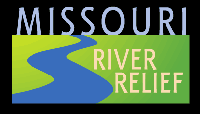Missouri River Relief (MRR) was in St. Charles, Missouri to host an Educator Workshop. This event brought teachers from around the Midwest, including formal and informal educators. There were eleven lucky participants, each one as excited as the next to be learning more about the Big Muddy and ways to spread that knowledge to others. The two-day workshop focused on both connecting participants to the Missouri River as well as detailing ways to integrate this knowledge into their classrooms and/or programs.
Day One:
After setting up registration at the boat ramp, participants began to arrive. Once everyone had signed in, Kristen, MRR education coordinator, organized us into a circle for introductions. The crew, including Jeff Barrow (MRR executive director), Jan Weaver (Missouri Environmental Education executive director) and myself (Kristen Schulte, the education coordinator), provided the participants with a brief background of ourselves, followed by the educators talking a little about themselves and their reason for coming. Although the individual reasons varied, they all shared an excitement to learn. After the introduction, we got everyone fitted for life jackets, and set off down-stream, with Jeff manning the wheel. Along the way, we made observations about the river, using “I notice, I wonder, It reminds me of…”
 |
| Educators make "I notice" observations on the river. |
 |
| Educators watch as a dredge pulls sand up from the bottom of the river. |
 |
| Educators learn about the Pallid Sturgeon through learning stations. |
This day, we spent our time on land at two locations: the Greater St. Charles Visitor Center and the Lewis & Clark Boat House & Museum.
 |
| Peer to peer discussions on how people learn. |
Day two was spent off the river and focused on student learning and understanding, as well as ways to integrate this information into the classroom. To begin, Kristen provided a template for what a Missouri River lesson plan might look like, igniting creativity throughout the educators for their own lesson plan construction to come.
 |
| Demo of a Missouri River Lesson Plan |
Then, we discussed the ways in which people learn, as well as how to integrate this into your lesson plan. We engaged in peer to peer and group discussion with a demo of a Missouri River lesson plan in-between. Then, we meet with a tour guide from the St. Charles Historical Society. We explored the red brick roads of St. Charles and its connection to the Missouri River. We ended our tour with a delicious lunch at Magpie’s Café.
 |
| Tour of early settlement on the Missouri River in St. Charles, Mo. |
After lunch, participants began working on lesson plans of their own. Educators were asked to bring copies of one of their own lesson plans, either to edit or to add new content. Participants used the knowledge gained from day one of the workshop to craft a unique lesson plan of their own! Topics included settlement along the Missouri River, biodiversity on the Missouri River, and people’s impact on the Missouri River.
Next, participants used giant post-it notepaper as a canvas for their lesson plans, which they then placed on the wall around the room. Individually, educators went around the room in a 'gallery walk activity', observing their colleagues work, and providing comments for praise and potential improvement by placing a post-it note on the lesson plan.
 |
| Transfering our lesson plans to poster board for peer feedback. |
If you would like to learn more about MRR educator workshops, please contact Education Coordinator Kristen Schulte at kristen@riverrelief.org. See you on the river!

No comments:
Post a Comment